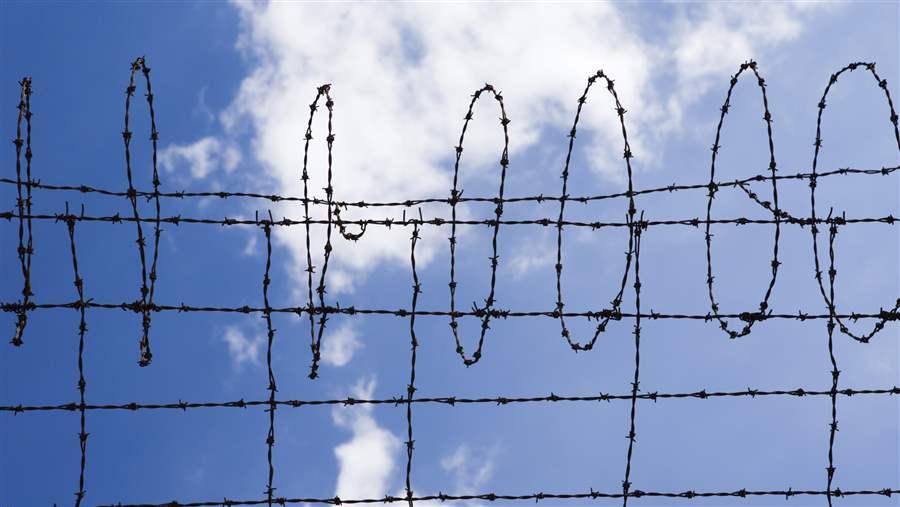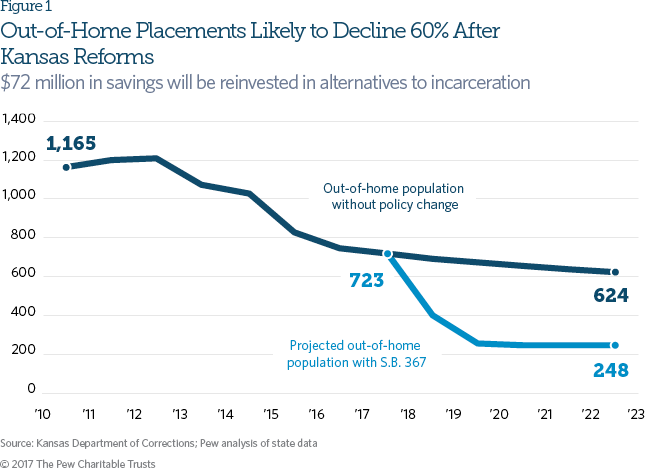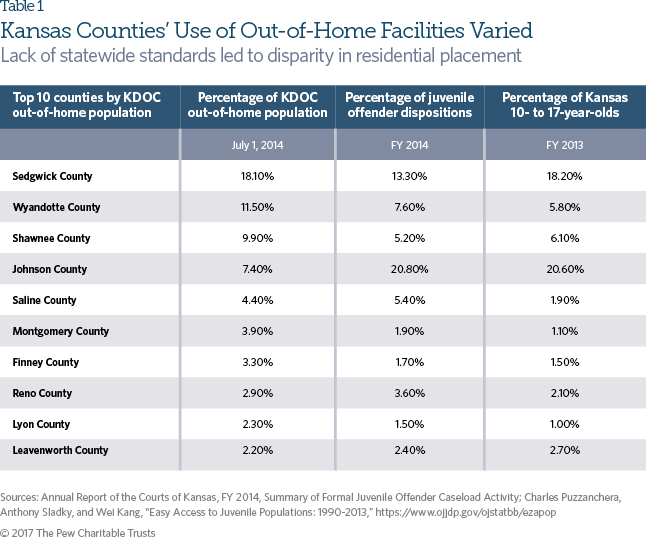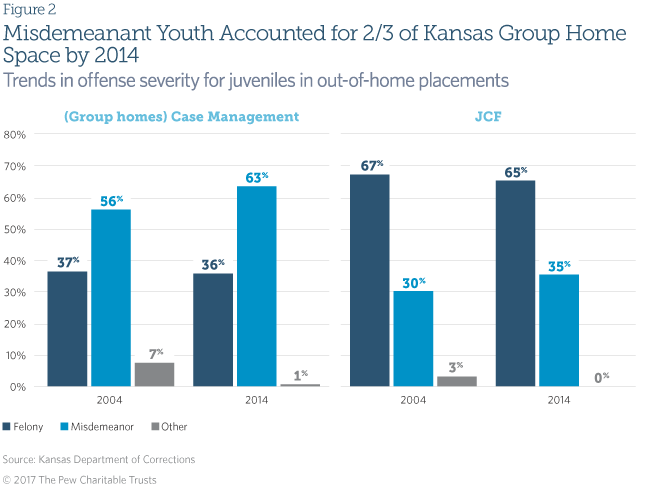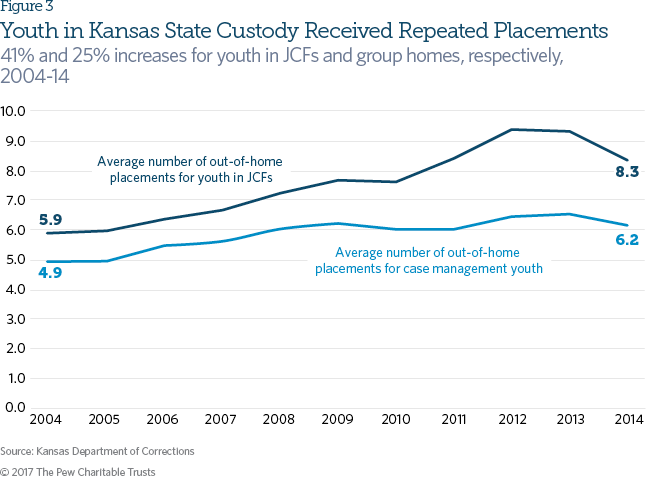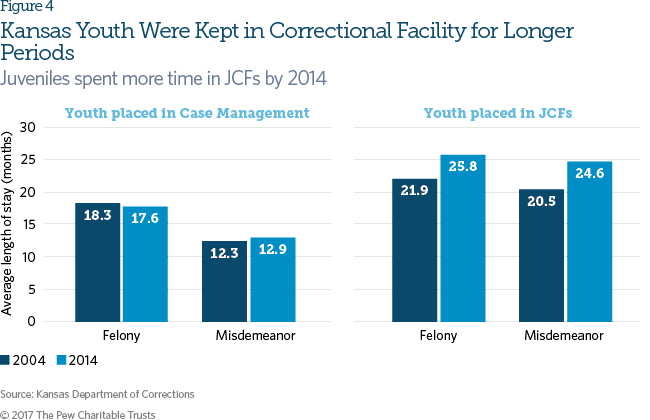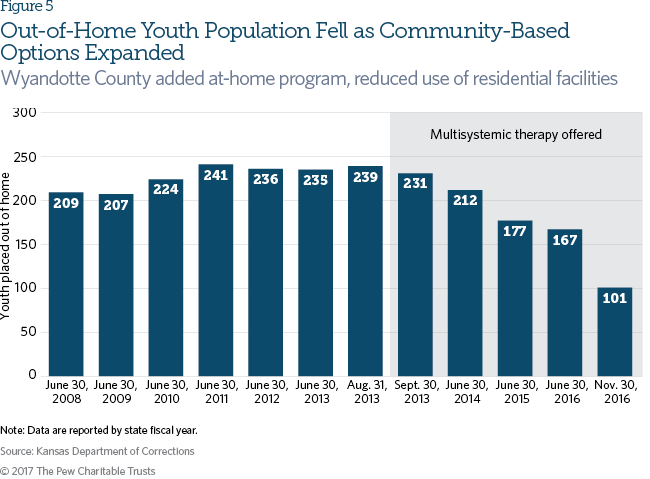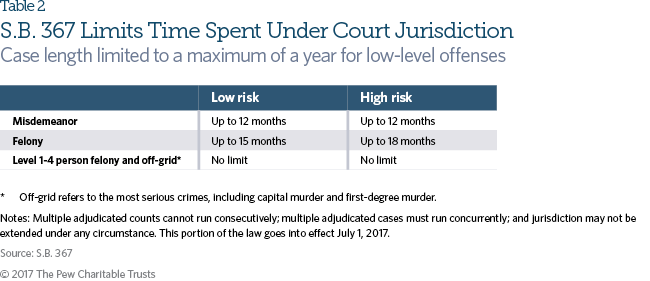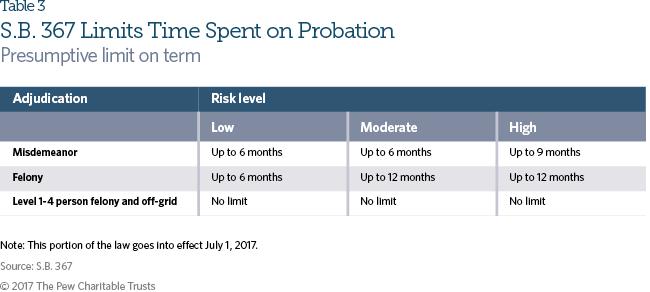Kansas' 2016 Juvenile Justice Reform
Figure 2 was updated on May 22, 2019, to clarify the type of case management and correct the share of youth placed in juvenile correctional facilities in 2014.
Overview
Seeking to improve its juvenile justice system, Kansas in 2016 enacted Senate Bill 367, which was based on the recommendations of a bipartisan work group appointed by leadership from all three branches of the state’s government. The law restricts the use of out-of-home placement, focuses intensive system responses on the highest-risk juveniles, and shifts significant resources toward evidence-based alternatives that allow youth to be supervised safely while remaining at home. It is projected to cut residential placements by more than half and yield $72 million for reinvestment over five years.
Highlights
Problem
Juvenile arrests fell more than 50 percent in Kansas between 2004 and 2013, mirroring declines nationally, but the number of youth held in residential facilities declined by just 24 percent during the same period.1 Over those same nine years, Kansas cycled its youth through more placements and held them for months longer than it had a decade earlier. Research shows that residential commitments generally fail to reduce reoffending, yet the state spent $89,000 per youth on secure facilities annually.
Findings
In 2015, the work group conducted a comprehensive analysis of Kansas’ juvenile justice system, reviewing data from across state agencies and the courts and gathering extensive stakeholder input. The work group found that a scarcity of evidence- and community-based interventions combined with a lack of statewide standardized practices led to geographically inconsistent outcomes and an out-of-home population largely composed of lower-level youth.
Reforms
Passed by overwhelming bipartisan majorities in both legislative chambers, S.B. 367 establishes consistent statewide standards to reduce disparate outcomes, prohibit out-of-home placement for lower-level youth, focus intensive system resources on the highest-risk juveniles, and sustain effective practices through continued oversight of and reinvestment in evidence- based services in the community.
Impact
Kansas officials expect that S.B. 367 reforms will reduce the out-of-home youth population by approximately 60 percent by 2022 and save $72 million, which will be reinvested in alternatives to incarceration. (See Figure 1.) The Kansas Legislature appropriated $2 million in 2016 to kick-start the expansion of community programs, and in late 2016, the Kansas Department of Corrections (KDOC) announced plans to close one of two juvenile correctional facilities by March 2017.
Background
In 2015, Kansas leaders recognized the need to reform the state’s juvenile justice system after various reports raised questions about case processing and youth outcomes. For example, a KDOC review found that youth removed from their families and placed in group homes often did not receive appropriate treatment and were not effectively prepared for release. The study found that most juveniles discharged from group homes were back in residential placements within six months.2
Juvenile justice reform has been a priority for my administration. I appreciate the honest assessment of what’s working and what we could do to better align our state with what the research says works. I wanted to see recommendations that help Kansas protect public safety and improve outcomes across our juvenile justice system. This piece of legislation accomplishes that.Governor Sam Brownback, S.B. 367 ceremonial bill signing, April 11, 2016
In response, Governor Sam Brownback (R), Chief Justice Lawton Nuss, and legislative leadership from both chambers established the Kansas Juvenile Justice Workgroup. The 17-member team consisted of representatives from across the juvenile justice system and received technical assistance from The Pew Charitable Trusts and the Crime and Justice Institute at Community Resources for Justice. (See the list of members on Page 15.) State leaders directed the work group to study the juvenile justice system and develop consensus recommendations to:
- Promote public safety and hold juvenile offenders accountable.
- Control taxpayer costs.
- Improve outcomes for youth, families, and communities.
The work group met monthly from June through November 2015. Members began by analyzing state data trends that shed light on how cases entered, progressed through, and exited the juvenile justice system. A review of state juvenile justice statutes, policies, and practices helped the work group better understand the factors influencing decision-making at each stage of the process. Next, work group members held more than two dozen roundtable discussions across the state and surveyed hundreds of community supervision officers to enhance and corroborate the key data findings. Finally, the work group reviewed a large body of juvenile justice research,3 beginning with presentations from Mark Lipsey and Edward P. Mulvey, two leading experts in the field.4
After this comprehensive assessment, members held 16 subgroup meetings to discuss the findings, review additional research, and reach consensus on policy responses. In December 2015, the work group issued a report to state leadership outlining its findings and 40 data-driven recommendations, which were subsequently introduced to the Legislature through S.B. 367. An amended version of the bill passed the Senate unanimously and the House by a 118-5 vote before being signed into law by Gov. Brownback on April 11, 2016.\
S.B. 367 Proponents
- Kansas Sheriffs Association
- Kansas Association of School Boards
- Kansas Big Brothers, Big Sisters
- Kansas Association of Chiefs of Police
- ACLU of Kansas
- Association of Community Mental Health Centers of Kansas Inc.
- Kansas Community Corrections Association
- Kansas Department of Corrections
- Kansas Action for Children
- Kansas Appleseed
- Kansas Association of Community Action Programs
- Kansas Association of Criminal Defense Lawyers
- Kansas Center for Economic Growth
- Kansas Legislative Education and Research Inc.
- Kansans United for Youth Justice
- Keys for Networking Inc.
- National Alliance for Mental Illness, Kansas Chapter
- The Kansas Advisory Group on Juvenile Justice and Delinquency Prevention
Key findings
The work group made several key findings:
Juvenile crime fell, but out-of-home placements did not keep pace
Kansas experienced a more than 50 percent decline in juvenile arrests between 2004 and 2013 as well as a drop in violent juvenile crime that exceeded the national average.5 In many states, out-of-home youth placements will rise and fall roughly in parallel with annual arrests. In Kansas, however, the population of delinquent youth placed in residential facilities did not have a corresponding decrease. Between 2004 and 2013, the out-of-home population fell by only 24 percent, just half the drop in arrest rates.
Disparate reliance on out-of-home placement across jurisdictions
Judges, whose ability to place youth in state juvenile correctional facilities (JCFs) is statutorily limited, had broad discretion to order placements in other out-of-home locations, including group homes and detention facilities.
Judges could take this action in response to nearly any circumstance, either at initial case disposition or after violations of community supervision. In addition, statutory criteria limiting JCF commitments could be—and, according to stakeholders, often were—circumvented through “departure” proceedings in which the court imposed a more severe sentence than provided for by statute. The work group found considerable disparity across Kansas’ 105 counties in the share of youths in out-of-home placement relative to their total juvenile populations and/or their number of youth offenders. (See Table 1.)
Costly out-of-home placements increasingly used for low-level youth
Data showed that as the arrest rate for violent juvenile crime decreased, a larger share of out-of-home placement space was used for youth adjudicated delinquent for low-level offenses. The overall proportion of misdemeanants in residential placements began to increase in 2004 and by 2014 accounted for roughly two-thirds of the youth in nonsecure facilities and one-third of those in the JCFs. (See Figure 2.) Moreover, more than 90 percent of youth in out-of-home placements had two or fewer prior adjudications before they were first placed.
Research shows that removing youth from their homes does not typically improve outcomes and can increase the likelihood of reoffending,6 particularly for low-level offenders. Despite such findings, KDOC spent more than two-thirds of its approximately $77 million fiscal year 2016 juvenile services budget—or about $89,000 per youth—on costly placements such as JCFs.
Youths subject to more and longer placements, frequent relocations
Neither statute nor policy guided the length of placement in nonsecure group homes and no limits were placed on the number of permissible placements during the course of a case or on the total time a youth could be kept in state custody. Data showed that in 2014, juveniles in out-of-home settings cycled through more facilities and stayed away from home longer than their counterparts had a decade earlier. For example, youth in the JCFs in 2014 received an average of 8.3 placements—41 percent more than in 2004—while those placed in nonsecure facilities had an average of 6.2 such placements, an increase of 25 percent. (See Figure 3.)
During the past decade, the length of JCF incarceration over the course of a case, including conditional release returns, jumped 30 percent to 15 months on average. Additionally, across felony and misdemeanor dispositions, youths in the JCFs spent an average of about 25 months out of home in 2014, including other placements, over the course of their cases, 16 percent more than in 2004. (See Figure 4.)
Secure detention increased
Unlike other correctional populations that experienced at least some decline, the number of adjudicated juveniles incarcerated in secure detention grew 27 percent between 2004 and 2014. Under state law, community supervision officers could arrest and detain youth on technical violations,8 and courts could impose detention. In some cases, status offenders, such as runaways and truants, continued to be held in secure detention before adjudication and on violations of valid court orders. Despite a 30-day statutory limit on the length of incarceration that the court could impose on delinquent youth at disposition—the juvenile equivalent of sentencing—data and stakeholder input indicated that different interpretations of the limit’s application sometimes led to longer stays.
Data showed that 30 percent of intakes in 2014 resulted in pre-adjudication detention, exceeding national estimates of 21 percent.9 One explanation lay in Kansas statutory criteria, which permitted almost all youth to be held pending adjudication. In addition, only a handful of the state’s counties used a detention risk assessment to guide pre-adjudication decision-making.
Group homes failed to improve outcomes and protect public safety
Most delinquent youth removed from their homes by the courts lived in group homes, at a cost of $50,000 a year on average. Research indicates that, compared with community supervision, these nonsecure facilities may increase many juveniles’ likelihood of offending.10 Further, the use of these out-of-home placements was not restricted to higher-risk youth, despite research showing that excessive involvement in the juvenile justice system can lead to negative outcomes for low-risk youth.11 The work group found that nonsecure facilities routinely housed young people of all risk levels.
Surveys of community supervision officers and stakeholder roundtables indicated that judges frequently placed youth in group homes to enhance access to evidence-based services. However, the work group found that this goal was not achieved because the homes did not provide evidence-based services and instead brought resident youth to the same community providers that served youth on probation. In addition, most of the services accessed during placement were neither shown to reduce recidivism nor monitored for quality by the juvenile justice system.12
Similarly, the supervision and support provided to youth in group homes were inconsistent. Among juveniles released from Case Management in 2014 who had spent time in group homes, more than a third (36 percent) had gone missing from such homes (defined as absent without leave, or AWOL) at least once, up from 26 percent in 2006. On any given day, more than 100 youths were AWOL, or roughly 1 in 6 juveniles assigned to group home placement, and 41 percent of AWOL youths were missing for a month or more.
Most juveniles who began their time in a group home (73 percent) cycled into another out-of-home facility on the same case, but the majority of comparable youths who started on intensive supervision probation (72 percent) tended to remain at home.
As judges, our hands are tied. They are tied by a lack of objective information in the courtroom, they are tied by a lack of clear guidelines from the state, and, most of all, they are tied by a lack of community-based options that research and successes in other states have repeatedly shown to work better than out-of-home placements to keep our communities safe and improve outcomes.Mary B. Thrower, district magistrate judge, 28th Judicial District, House Corrections and Juvenile Justice Committee, S.B. 367 hearing, March 7, 2016
Scarce resources for evidence-based alternatives to out-of-home placement
The work group found that evidence-based services for youth living at home were scarce in Kansas, even though research indicates that such programs produce better public safety outcomes than out-of-home placements at a much lower cost. The availability of alternatives also varied widely across the counties. For example, establishing an evidence-based multi-systemic therapy (MST) program for youth living at home enabled Wyandotte County to successfully cut out-of-home placements. (See Figure 5.) Statewide expansion proved difficult, however, in part because savings from reduced out-of-home placements were diverted to the state general fund and not reinvested in evidence-based services. The work group found that the availability of services depended largely on investments by individual jurisdictions and on the ability of KDOC to secure ad hoc pilot funds.
Inconsistent collaboration, data analysis, information sharing
Incongruent data systems and poor communication among the courts, community supervision officers, KDOC, and Department for Children and Families (DCF) caseworkers left decision-makers unable to quickly and securely access critical information at key decision points. For example, because the KDOC, DCF, and court data systems did not interact, case plans were not coordinated across different levels of supervision and often changed substantially when moving from one agency to another. Youths transferred to another level of supervision or with cases under supervision by different branches sometimes received duplicative services.
In addition to these data-sharing issues, state agencies lacked key data points: Apart from a minimal amount of data related to youth leaving a JCF, Kansas collected no information about rates of reoffending by adjudicated youth.
S.B. 367: Comprehensive juvenile justice reform
Based on these findings, the work group developed and unanimously endorsed 40 policy recommendations that became the foundation of S.B. 367. State officials expect the legislation to reduce the out-of-home juvenile population by approximately 60 percent by 2022, producing $72 million in savings that the law requires to be reinvested in evidence-based community alternatives to improve public safety and other outcomes. S.B. 367 incorporated reforms in four primary areas, consistent with the goals and recommendations of the work group:
- Prevent deeper involvement of youth with the juvenile justice system.
- Improve outcomes for youth supervised in the community.
- Focus resources on the most serious delinquent youth.
- Ensure the quality and sustainability of reforms.
Prevent deeper juvenile justice system involvement
Reduce school referrals through local collaboration and training: Kansas does not track school referrals of students to juvenile justice authorities, but stakeholders reported that schools directed a substantial number of youths into the system. The legislation mandates that school-based law enforcement officers and school administrators receive joint training in effective responses to misconduct and in strategies to reduce student exposure to the juvenile justice system while maintaining a safe, productive learning environment. S.B. 367 also requires that each school district develop and adopt memorandums of understanding to minimize the referral of school misconduct to law enforcement and the courts.
Standardize statewide diversion processes and remove barriers to participation: The bill establishes statewide criteria for enhanced pre-court diversion (i.e., alternative interventions to keep youth from entering the court process) to ensure swift, appropriate, and consistent responses to youth behavior in every jurisdiction across the state. Before sending a case to court, prosecutors must consider it for diversion, regardless of offense type or the youth’s history. New statutory criteria also mandate that misdemeanants with no prior adjudications and youth charged with “felony unlawful voluntary sexual relations” with no previous adjudications be offered a short diversion process. Inability to pay fines or fees may not be used to bar youths from participation in or to terminate them from such programs. The legislation also prioritizes diversion for reinvestment of savings from commitment reductions.
When I was appointed to the work group, I was not supportive of reform, given my law enforcement background and the murder of my daughter, Kelsey Smith. But as I pored over our state’s data and compared it with research about how to reduce reoffending and improve outcomes, my thinking changed.Senator Greg Smith (R), Kansas Senate Corrections and Juvenile Justice Committee, op-ed, Wichita Eagle, Feb. 23, 2016
Limit pre-adjudication detention by law enforcement: S.B. 367 creates the presumption that upon law enforcement contact, a juvenile will be sent home rather than removed from the home, unless reasonable grounds are found to believe such action would not be in the best interests of the youth or would pose a risk to public safety or property. The law also narrows pre-adjudication detention eligibility to youth who have been charged with more serious offenses. In those cases, the law requires use of a statewide detention risk assessment tool to guide the use of confinement rather than less restrictive alternatives such as home detention. Children in need of care, including status offenders, may not be securely detained under any circumstance but may, in certain circumstances, be lodged temporarily in a less restrictive setting such as shelter care. The bill requires the oversight committee to track juvenile incarceration to identify disparate impacts based on race, sex, national origin, or economic status.
Expand and improve community-based detention alternatives: The legislation requires that resources be redirected from secure detention to fund local evidence-based alternatives to out-of-home placement. It also expands statewide a protocol permitting law enforcement officers to issue a notice to appear for an intake appointment, even if parents cannot be located.
Focus court use of pre-adjudication detention: The new law narrows the parameters under which the court may keep a youth in detention, specifically focusing judicial attention on each youth’s risk of harm to others. S.B. 367 also requires regular review hearings for youth held by the court before adjudication.
Eliminate temporary custody for delinquency cases: S.B. 367 ends the practice of placing youth in out-of-home facilities for indeterminate periods before adjudication on the basis of alleged delinquent behavior.
Tailor length of court jurisdiction: S.B. 367 caps the length of the courts’ jurisdiction over cases based on each juvenile’s risk level and offense severity at initial disposition, excluding the most serious person felonies, such as homicide. (See Table 2.) Presumptive lengths for each level of supervision are similarly defined in statute and may be changed only under narrowly defined conditions. The case must terminate once the cap expires and may not be extended under any circumstance.
Limit criminal court jurisdiction to youth who commit the most serious offenses: S.B. 367 eliminates “extended jurisdiction juvenile prosecution” for all but the most severe person felonies, such as aggravated rape and homicide. It also makes adult prosecution of youth less likely and ensures that the default authority for youth is the juvenile system by shifting the burden of proof in criminal certification proceedings to the prosecution. In addition, the law raises the minimum age of eligibility for adult prosecution from 12 to 14 years and requires the criminal court to offer a preliminary hearing to all youths transferred for prosecution.
Decrease financial barriers that preclude completion of supervision: S.B. 367 removes a provision that prohibited youths from completing supervision until they paid any fees due to the supervising agency and prohibits continued court supervision for the sole purpose of settling financial obligations.13 Further, youth must be allowed to participate in and complete diversion programs regardless of ability to pay. The law also reinvests savings from reduced out-of-home placements into contracts for service providers, shifting the cost of assessment and treatment from youth and their families to the state.
Improve outcomes for youth supervised in the community
Tailor the length of time juveniles spend under community supervision: The law creates a presumptive limit on the length of probation terms based on youths’ risk levels and offense severity and prohibits extension of the term except for a single, short period under very narrow circumstances. (See Table 3.) Conditional release (parole), if ordered, is similarly limited. Neither type of community supervision may exceed the overall jurisdictional limit except for the most severe person felonies.
Probation may be extended only if a juvenile needs time to complete an evidence-based program that was deemed necessary by a validated risk and needs assessment, and a case may be briefly prolonged once for good cause. Data regarding probation extensions must be recorded and reported quarterly to the Kansas Juvenile Justice Oversight Committee.
Tailor supervision, services, and system responses to youths’ risk and needs: KDOC and the Office of Judicial Administration (OJA) must develop a uniform case plan for each juvenile on supervision. The plan must be informed by a risk and needs assessment and be appropriate to the assessed level. Supervising officers must involve youths and, when appropriate, their families, schools, and DCF in planning.
Develop a continuum of community-based responses: Stakeholders must create a statewide system of predictable, structured, and appropriate actions to be taken to address the conduct of youth on supervision. The responses must be swift and certain, provide rewards and sanctions for positive and negative behaviors, and target youths’ risk and needs and the type of behavior. The response system is to be established collaboratively by KDOC and OJA.
Encourage compliance through consistent earned discharge policies and credit for time served: The law requires KDOC and OJA to develop a standardized, consistent earned discharge policy for all youth. The policy will apply statewide to promote compliance with the terms of probation and other levels of supervision. It also requires the courts to give youth credit toward their sentences for time served in detention or under house arrest before disposition to a JCF or adult prison. These requirements will allow court service officers, community corrections officers, and JCF staff to focus on higher-risk youth.
Improve responses to noncompliance: S.B. 367 requires that supervising officers document a pattern of technical violations and failed remediation efforts before filing a petition to revoke supervision. Acceptable strategies for responding to violations will be guided by the new statewide continuum of graduated sanctions and incentives, also developed under the law. Further, youth may not be removed from their homes for technical violations, except violations of parole requirements, and in those cases they may not be returned to the JCF. The law also removes from supervising officers the authority to arrest and detain youth and sets specific parameters for warrant requests: The juvenile must have violated a condition at least three times and pose a significant risk of physical harm to another person or damage to property.
Focus resources on the most serious delinquent youth
Tailor the use of residential resources by clearly defining eligibility for removal from the home: To remove a youth from the home after adjudication, the court must satisfy a specific set of statutory criteria that limits placement to higher-level juveniles. For example:
- Limit detention to public safety risks: Detention may no longer be used simply as a disposition. Instead, incarceration in secure detention after adjudication must be reserved for youth on supervision who pose a significant risk of harm to another person or of damage to property, score as “detention-eligible” on a standardized detention risk assessment instrument, are charged with a new felony offense, or are in violation of conditional release, which is similar to adult parole.
- Limit incarceration in the Juvenile Correctional Facility to the most serious youth: To incarcerate a juvenile in the JCF, the court must make findings of fact and enter into the written record a determination that the youth poses a significant risk of harm to another person or damage to property. The court must then find that the youth is eligible according to revised criteria that specify eligible felony offenses and corresponding history and assessed risk requirements.14 Misdemeanants and violators of conditional release may no longer be placed in JCF custody under any circumstance.
- Eliminate group homes for delinquent youth: The courts may no longer directly commit juveniles to group homes. However, KDOC may use a limited number of group homes as an alternative to JCF incarceration for youth ages 11-13 who would otherwise be committed to the JCF and the lowest level of felony offenders eligible for JCF incarceration. By 2018, KDOC must reduce group home capacity to no more than 50 spaces for that limited population.15
- Eliminate the “valid court order” exception for status offenders: Status offenders may not be held in secure detention under any circumstance.16
Limit the length of time youth spend out of the home: New provisions restrict cumulative detention time to 45 days over the course of a youth’s case and reduce the amount of time juveniles can spend in KDOC out-of-home placements to bring lengths of stay more in line with research about what works to effectively reduce recidivism. The law authorizes exceptions to these provisions for only the most severe person felonies.
Improve reintegration and re-entry for youth released from residential facilities: Conditional release will no longer be mandatory for youth committed to the JCF but may be ordered at the discretion of the court.
Renewed focus will be placed on reintegration, and collaborative planning will begin immediately upon a youth’s incarceration in the JCF. Courts, local stakeholders, and victims, where appropriate, will be notified of a youth’s pending release, and upon such notification, judges may hold a hearing to impose a period of conditional release if none was previously ordered.
Ensure the quality and sustainability of reforms
Invest in community-based programs across the state: The state budget allocates $2 million in upfront funds to kick-start efforts to expand evidence-based community programming for delinquent youth statewide.
S.B. 367 also requires that savings from reductions in out-of-home placements be invested in evidence-based, local options to promote home-based responses—including pre-court diversion and detention alternatives and post-disposition probation and conditional release—at every stage of a youth’s interaction with the system. The legislation prioritizes programs that focus on the risks and needs most associated with criminal behavior, including cognitive-behavioral and family-centered therapies, substance abuse, and sex offender therapy.
This right-sizes our juvenile justice priorities. It will help generations of Kansas kids to get out of the system, stay out of the system, and live better lives.Representative Blaine Finch (R), March 24, 2016, House floor speech, S.B. 367 debate
Monitor programs for fidelity to their models: The legislation requires that programs as well as training efforts be monitored for adherence to evidence-based practices to ensure the best possible recidivism- reduction outcomes.
Provide specialized training for juvenile justice professionals: S.B. 367 requires that all staff from the courts, KDOC, and community corrections; law enforcement in schools; service providers; and any other institution that works with diverted or adjudicated youth receive training in evidence-based practices that reduce reoffending. The law also mandates the development of a model training protocol for judges, county and district attorneys, and defense attorneys who work in juvenile courts.
Improve the quality of juvenile defense statewide: The law authorizes an oversight committee to investigate and make recommendations regarding juvenile due process rights and provides regular juvenile-specific training to juvenile defense attorneys.
Establish a statewide oversight committee: S.B. 367 creates a governmental entity to oversee implementation of the reforms and continue reviewing the system to uncover other areas in need of improvement. The committee must meet at least quarterly to create and review performance measures to gauge policy outcomes, calculate and recommend investment of savings from incarceration reductions, and study new areas for additional policy reform.
Redefine the role and composition of local oversight bodies: The law empowers local juvenile correctional advisory boards to determine community needs and coordinate with the statewide oversight committee. It also enhanced their membership with the addition of a defense bar representative.
Require data collection and reporting to track outcomes and continue to improve the system: S.B. 367 requires expanded data collection and information sharing at every stage of the system, from schools to state custody placements. Under this mandate, Kansas will be able to monitor whether public safety outcomes are improving statewide and detect any unintended outcomes of the reforms.
2015 Kansas Juvenile Justice Workgroup
- Senator Greg Smith, District 21, co-chair
- Representative John Rubin, District 18, co-chair
- Ed Klumpp, Chief of Police-Retired, Topeka Police Department and lobbyist for the Kansas Association of Chiefs of Police, the Kansas Sheriff’s Association, and the Kansas Peace Officers Association
- Ray Roberts, former secretary, Kansas Department of Corrections
- Judge Thomas Foster, 10th Judicial District
- Judge Mary Thrower, 28th Judicial District
- Karen Griffiths, assistant county attorney, Norton County
- Senator Pat Pettey, District 6
- Mark Gleeson, Director of Trial Court Programs, Office of Judicial Administration
- Judge Delia M. York, 29th Judicial District
- Stephanie Springer, 27th Judicial District chief court services officer
- Terri Williams, deputy secretary of juvenile services, Kansas Department of Corrections
- Representative Gail Finney, District 84
- Randy Bowman, director of community-based services, Kansas Department of Corrections
- Melody Pappan, Director, Cowley County Youth Service
- Trent Wetta, Staff Attorney, Kansas Legal Services
- Jaime Rogers, Deputy Secretary of Family Services, Kansas Department for Children and Families
Early signs of success
The provisions of S.B. 367 will require several years to take full effect, but early signs of progress are encouraging.
Juvenile correctional facility closed: Citing continued declines in incarceration levels, KDOC on March 3, 2017, shuttered one of its two juvenile correctional facilities: the Larned Juvenile Correctional Facility, which was funded to operate as a 128-bed facility but had a month-end population of just 35 in October 2016.17 KDOC has committed to ensure that Larned staff members have the opportunity to remain state employees and is engaged in ongoing efforts to improve the quality of programming available to system-involved youth across the state.
To these ends, the department is transferring eight Larned positions to the state office to support new training and fidelity monitoring efforts for evidence-based programming systemwide. The transfer of additional Larned staff members to the remaining JCF will allow the state to meet federally required staffing ratios that go into effect in October 2017.
Group home and detention populations decline: Like JCF incarceration levels, other state custody populations also continued to decline after passage of S.B. 367. For example, the statewide month-end population of youth in detention fell from 123 in July 2016 to 100 in February 2017, and during the same period, the group home population dropped from 145 to 108. As KDOC moves toward the 2018 limit of no more than 50 group home spaces, it has begun a performance-based contracting process to promote improved practices in remaining facilities.
Oversight committee appointed and convened: On Oct. 24, 2016, the Kansas Juvenile Justice Oversight Committee convened for the first time in Topeka. The panel is charged with guiding implementation of the changes in law; approving processes for comprehensive data collection to measure performance, recidivism, costs, and outcomes; ensuring system integration and accountability; monitoring implementation and training efforts; calculating avoided state expenditures from reductions in out-of-home placements; and continuing to review the juvenile justice system for further improvement opportunities.
Evidence-based programming receives $3 million investment: To kick-start the expansion of evidence-based community programming before reinvestment dollars from reduced placements become available, the 2016 Kansas Legislature allocated $2 million to KDOC on July 1, 2016. Since that time, KDOC has directed those funds toward statewide services and plans for quality assurance. Requests for proposals for functional family therapy, for example, were issued in August 2016, and the service began operating for moderate- and high-risk youth in February 2017. Investments were also made in expanded aggression replacement training. Previously used in the JCF, this model expanded to staff in Sedgwick and Wyandotte counties for use with youth living at home. Plans for statewide expansion of the program as well as cognitive-based therapies are ongoing. In addition, the Youth Advocate Program was made available in October 2016 to 14 judicial districts as an alternative to out-of-home placement, with statewide expansion anticipated in fiscal 2017. Finally, statewide sex offender assessment and community-based treatment became available in July 2016.
To supplement the initial legislative investment of $2 million, the Kansas Advisory Group on Juvenile Justice and Delinquency Prevention invested $1 million to support development of detention alternatives and strategies to reduce disproportionate contact of minority youth with the juvenile justice system.
Endnotes
- Unless otherwise cited, all analyses in this report were conducted by The Pew Charitable Trusts and the Crime and Justice Institute at Community Resources for Justice using data provided by the Kansas Department of Corrections, the Kansas Office of Judicial Administration, and the Kansas Department for Children and Families.
- Kansas Department of Corrections, “Cost Study of Youth Residential Centers for Juvenile Offenders: Pursuant to Senate Substitute for House Bill 2588” (Jan. 15, 2015), https://www.doc.ks.gov/publications/juvenile/yrc.
- Edward P. Mulvey et al., “Trajectories of Desistance and Continuity in Antisocial Behavior Following Court Adjudication Among Serious Adolescent Offenders,” Development and Psychopathology 22 (2010): 453–75, doi: 10.1017/S0954579410000179; Daniel S. Nagin, Francis T. Cullen, and Cheryl Lero Jonson, “Imprisonment and Reoffending,” in Crime and Justice: A Review of Research, ed. Michael Tonry (Chicago: University of Chicago Press, 2009), 115–200; Patrice Villettaz, Gwladys Gillieron, and Martin Killias, “The Effects on Re-Offending of Custodial vs. Non-Custodial Sanctions,” Campbell Systematic Reviews (2015), doi:10.4073/csr.2006.13. These reviews synthesize the results of individual adult and juvenile justice studies that compared the effects on recidivism of custodial sanctions with those of alternatives. The weight of the evidence suggests that incarceration does not reduce recidivism. See also Christopher T. Lowenkamp and Edward J. Latessa, “Evaluation of Ohio’s RECLAIM Funded Programs, Community Corrections Facilities, and DYS Facilities” (2005), University of Cincinnati, Division of Criminal Justice, Center for Criminal Justice Research, http://www.uc.edu/content/dam/uc/ccjr/docs/reports/project_reports/ Final_DYS_RECLAIM_Report_2005.pdf; Paula Smith, Claire Goggin, and Paul Gendreau, “The Effects of Prison Sentences and Intermediate Sanctions on Recidivism: General Effects and Individual Differences” (2002), Public Safety Canada, https://www.publicsafety.gc.ca/cnt/rsrcs/pblctns/ffcts-prsn-sntncs/index-en.aspx.
- Mark W. Lipsey is director of the Peabody Research Institute at Vanderbilt University and the lead researcher on a meta-analysis of research on interventions with juvenile offenders, which generated guidelines for effective practice that are being implemented in 10 state juvenile justice systems. His work has been recognized by the American Society of Criminology, the American Parole and Probation Association, and the Society for Prevention Research, among others. He is a member of the Science Advisory Board for the federal Office of Justice Programs of the U.S. Department of Justice and co-author of the recently released Handbook for Evidence-Based Juvenile Justice Systems. Edward P. Mulvey, Ph.D., is professor of psychiatry and director of the Law and Psychiatry Program at Western Psychiatric Institute and Clinic at the University of Pittsburgh School of Medicine. He has conducted numerous research studies on violence, mental illness, and service provision in the juvenile justice system. He was a member of the MacArthur Foundation Network on Adolescent Development and Juvenile Justice and two recent National Academy of Sciences panels that assessed juvenile justice reforms and serves on the Science Advisory Board for the Office of Justice Programs of the U.S. Department of Justice.
- U.S. data: Office of Juvenile Justice and Delinquency Prevention, “Easy Access to FBI Arrest Statistics, 1994-2012,” accessed June 21, 2015, https://www.ojjdp.gov/ojstatbb/ezaucr.
- Edward P. Mulvey et al., “Trajectories of Desistance and Continuity in Antisocial Behavior”; Daniel S. Nagin, Francis T. Cullen, and Cheryl Lero Jonson, “Imprisonment and Reoffending”; Martin Killias, Patrice Villettaz, and Isabel Zoder, “The Effects of Custodial vs. Noncustodial Sentences on Re-Offending”; Christopher T. Lowenkamp and Edward J. Latessa, “Evaluation of Ohio’s RECLAIM Funded Programs, Community Corrections Facilities, and DYS Facilities”; Paula Smith, Claire Goggin, and Paul Gendreau, “The Effects of Prison Sentences and Intermediate Sanctions on Recidivism.”
- Judges had discretion to continue a case indefinitely until the youth reached age 21. In certain circumstances, jurisdiction extended to age 23.5.
- A technical violation is noncompliant behavior that does not constitute a new crime.
- Office of Juvenile Justice and Delinquency Prevention, “Easy Access to Juvenile Court Statistics: 1985-2013,” accessed June 21, 2015, http://www.ojjdp.gov/ojstatbb/ezajcs.
- Edward P. Mulvey et al., “Trajectories of Desistance and Continuity in Antisocial Behavior”; Joseph P. Ryan, Laura S. Abrams, and Hui Huang, “First-Time Violent Juvenile Offenders: Probation, Placement and Recidivism,” Social Work Research 38, no. 1 (2014): 7–18, https://doi.org/10.1093/swr/svu004. Summary available at http://journalistsresource.org/studies/government/criminal-justice/first- time-juvenile-offenders-probation-and-recidivism-evidence-from-los-angeles#sthash.9nVO2GEs.dpuf.
- Mark Lipsey and Edward P. Mulvey, presentation to the Kansas Juvenile Justice Workgroup, Sept. 8 2014.
- Ibid.
- In the event that monetary restitution is owed, it would become a judgment against the juvenile in accordance with KSA 38-2361(d)(2).
- Under the revised code, eligibility for commitment to the JCF is limited to juvenile offenders adjudicated for off-grid crimes, level 1-6 person felonies, or level 1-3 drug felonies and those deemed high risk by validated, uniform risk assessment and adjudicated for level 7-10 person felonies (with one prior felony adjudication), level 4 drug felonies (with two prior felony adjudications), or present nonperson felonies (with two prior felony adjudications).
- For youths adjudicated for sex crimes in which the victims reside in the home and adequate safety plans cannot be developed to keep the juveniles at home, short-term alternative placement options such as emergency shelters, community integration programs, and therapeutic foster care may be ordered by the court. If crisis intervention or short-term stabilization is necessary, the court may hold a youth for no more than 72 hours in a noncorrectional setting such as an emergency shelter or other respite care.
- Pursuant to the federal Juvenile Justice and Delinquency Prevention Act, status offenders may not be placed in residential facilities. Some states, however, permit courts to incarcerate those who violate a valid court order, such as not attending school, running away from home, or missing curfew.
- Kansas Juvenile Correctional Facility Population Activity, fiscal year 2017, October 2016 monthly report,http://www.doc.ks.gov/publications/juvenile/population/jcf.
